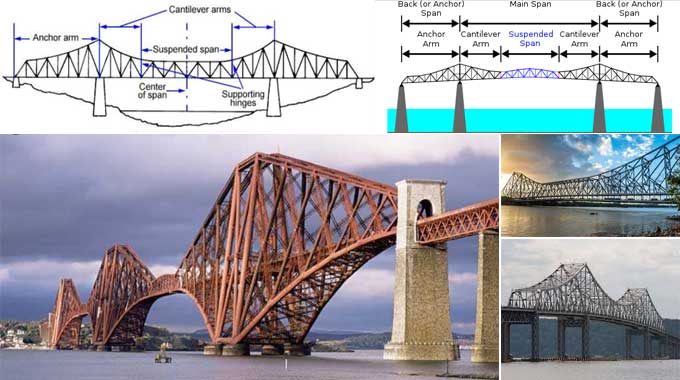
Interesting facts you need to know about Cantilever Bridges

Cantilever Bridges are frequent in major cities, and cantilever bridges are common in movies. Although you've probably seen them, you might not know what they're called; they're long cantilever bridges that can support huge weights.
This style of bridge is made of cantilevers, which is why it is called a cantilever bridge. A cantilever is a construction that has one fixed end while the other ends are free. The other end protrudes horizontally into space and serves to support the bridge. The lower end of each cantilever is fixed or fastened to the ground, while the higher end of the cantilever supports the bridge itself.
The Cantilever Bridge is a widely used bridge around the world. These bridges are widely used mainly because they do not require any support. Cantilever bridges are usually built when many supports are not possible.
How does the Cantilever bridge work?
Cantilevers must be firmly anchored on one side in order to carry the necessary weight on the free side and to avoid shear stress. A common example of a small overhang is a trampoline. One side is firmly attached to the ground, allowing the other side to support the weight of a person floating above the water. The cantilevers must withstand tension on the upper supports and compression on the lower ones.
Sometimes a gap or waterway is too wide to be bridged by a cantilever on each side. An example of a suspension bridge is one in which a girder or truss bridge is built between the arms of the two cantilevers, enabling them to be connected into one.
A balanced cantilever is another technique for bridging great distances. In this situation, the engineers build a dock in the middle of the river. They then anchor two outriggers to the dock, each pointing in opposite directions. These cantilevers or anchor arms meet other cantilevers anchored to the ground or another pier to create a complete bridge.
Do you know about the types of Cantilever bridges?
Cantilever Bridges can be classified into two different types, which are mentioned below:-
1. Balance Cantilever Bridges
2. Continuous Cantilever Bridges
Balance Cantilever Bridges
Bridges with spans of 50 to 250 meters are built using the cantilever technique. The bridge can be prefabricated or built on-site. Furthermore, the balanced cantilever construction method's basic principle is to link segments alternately at the opposite ends of the peer-supported cantilevers.
This method is easily adaptable to lengthy and irregular spans, congested project sites, hilly and aquatic topography, railway crossings, and environmentally valuable areas. It is also perfect for the construction of cable-stayed bridges. New struts support the voussoirs after they are put at each step of assembly.
This removes the need for supplementary supports, making it cost-effective and feasible for long cable-stayed bridges. The length of the structure must be limited when using a single lifting device to prevent lifting at the opposite end. The benefits of a cantilever balancing bridge are its ease of transport and continuous construction. Cantilever bridges, like continuous bridges, required simply a row of supports on the piers.
Continuous Cantilever Bridges
A continuous cantilever bridge is composed of two frames attached at the opposite ends of the pier to the center of the structure. It is imperative that the pillars be heavy in order to compensate for the lack of a balanced cantilever.
The continuous cantilever bridge consists of a continuous beam that spans two supports and keeps its bending moment and shear strength constant during the span of the beam. Bridges with continuously connected trusses are structurally stable due to stiff truss connections.
What are the benefits of using this Cantilever Bridge?
Here are a few lists of the benefits of using these Cantilever Bridges:-
1. During the construction of this bridge, only one side support is provided for each cantilever.
2. The falsework on these bridges, with the exception of the pier, does not need to be performed.
3. It is suitable for deep, rocky gorges and rivers prone to flooding where falsework may be dangerous or difficult to build.
4. Bridge construction, which takes place from each support pier, does not disrupt navigation beneath the bridge. It is common practice to construct bridges over busy roads and difficult crossings so that traffic can flow uninterrupted.
5. Unlike typical beams, these bridges may have a longer span due to the beams being connected at the cantilevers' extremities.
6. It is possible to link two cantilever spans using a suspended truss bridge, which is easy to construct.
7. If quality and consistency are important, the deck can be constructed in pieces.
What are the possible drawbacks of using this Cantilever Bridge?
Here the possible a few drawbacks of using these Cantilever techniques for building the bridges:-
1. There was an enormous amount of tension created during the construction of these bridges.
2. It is necessary to utilize a huge structure to provide stability to massive forces generated by the cantilever bridge. The bridge generates tensile and compression forces.
To learn more, watch the following video tutorial.
Video Source: Spark
3. When a joint section is used in this type of bridge, it results in handicaps on the RCC floor.
4. Weather conditions are not conducive to using this type of bridge.
5. It is necessary to build a large and sturdy support pier for the cantilever arm of the cantilever bridge.
Ending Statement
The basic cantilever bridge is made up of two arms that extend from opposite sides of the obstacle to be crossed and meet at the center. In contrast to temporary support towers and cables above cantilever bridges, falsework may not be needed under them, their main advantage is this. Furthermore, they're extremely stiff, so they can withstand a lot of weight without being damaged.


